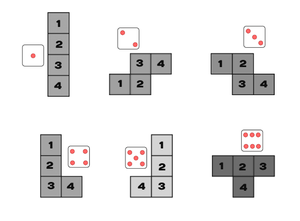Moon Drop
Jump to navigation
Jump to search
- Early draft of a replayable roll-and-write dice game based on The Twenty-Fifth Dynasty of Kevan, as discussed on the Slack channel.
You will need
- Four white dice and one blue (or any five dice; you'll just have to roll them in turn)
- A 9x9 grid on a sheet of paper, for each player
- A pen for each player
Gameplay
The game is played over seven rounds. Start each round by generating a block:
- One player rolls all five dice
- The blue die determins the block shape (per diagram to the right)
- The white dice should then be shaped to form that block, placing the lowest white die on the 1 square, the next lowest on the 2, and so on
Each player then copies that block onto their grid, in any location and rotation they wish. It can't overwrite existing blocks, and blocks can only be rotated, not mirrored. The white dice values correspond to:-
- Corridor. Initially drawn as a line from the centre of a square to the block it's joined onto. Players should extend corridors into corners and junctions and crossroads as the game progresses; this is just a visual shorthand, they're all just corridors.
- Quarters. Drawn as a Q.
- Life Support. Drawn as a triangle.
- Hydroponics. Drawn as four circles in a 2x2 pattern.
- Dock. Drawn as a cross.
- Research. Drawn as a square.
Continue placing until seven rounds have been played, then proceed to scoring.
Scoring
- to be written
Variations to test
- Allow blocks to be mirrored: this requires only five faces on the blue die (and could bring back the 2x2 block), so the sixth face could be some kind of free placement.
- Allow players to overwrite blocks, but destroying that square in the process (scribbling it out).
- Have corridors function based on how they're drawn: you can choose not to join a corridor to an adjacent block.
